Join More Than 50,000+ Subscribers and get latest camera news and rumors
NEW CAMERA VIDEOS ON YOUTUBE
|
By admin, on February 11th, 2023
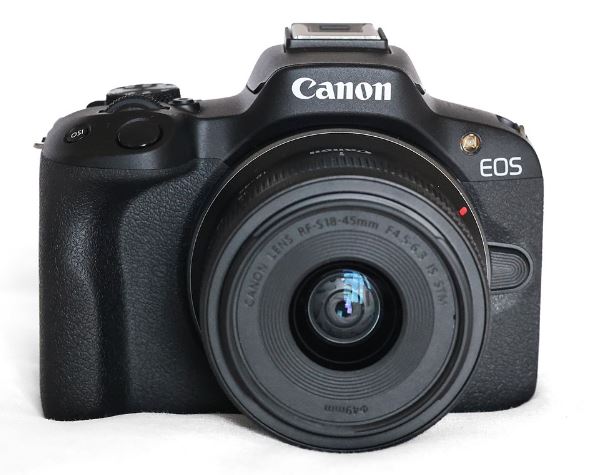
Yes, the Canon R50 camera doesn’t have a fully mechanical shutter inside the camera, instead of that we have HYBRID and ELECTRONIC. Shutter
Just after the announcement of the Canon R50 camera, I am getting lots of msgs from my users about why we have only two options on the shutter menu of the camera that say
- Elec. first curtain shutter
- Electronic only
But, when you go the burst mode, you have two options: the first is a 12FPS mechanical, and the second is a 15fps electrical shutter.
Ideal Condition to remove Mechanical shutter from your camera
- Condition 1: If the camera sensor has a GLOBAL SHUTTER without any lag, yes the camera doesn’t need any mechanical shutter.
- Condition 2: When a Camera Maker is using a STACKED CMOS Sensor inside the camera as we have in Nikon Z9, Sony ALPHA A1, or Canon R3, OR EVEN a re-worked FSI (Front Side illuminated Sensor) like we have in Canon R6 Mark II and Canon R8.
Now, these are the ideal condition to remove MECHANICAL SHUTTER completely from your camera.
THE BIG BUT
If your camera uses a slow traditional FSI (Front Side illuminated Sensor) and even knowing those stuff you completely attempt to remove the Fully Mechanical Shutter system from your camera it’s not recommended.
Since Both the EFCS Shutter and the Fully Electronic Shutter have some limitations. Specifically when paired with slow-readout-based sensors.
BASIC RULES TO FOLLOW as a PHOTOGRAPHER
1. If the shutter speed drops below 1/100 turn EFCS ON to prevent the front mechanical curtain from affecting your sharpness.
2. If the shutter speed goes above 1/1000 and you shoot a shallow depth of field turn EFCS OFF. The reason is that EFCS affects badly defocus characteristics of lenses when going above 1/1000
If your shutter speed is in between 1/100 and 1/1000 it is your call what to use. In general, when you do not shoot shallow depth-of-field portraits EFCs turned on is a good thing. When you put on the 135/1.8 or the Batis lens or even the 55/1.8 EFCS MUST go if you want nice bokeh
SHARE YOUR THOUGHTS WITH US
If the decision to remove the mechanical shutter from Canon R50 is correct?
Get LIVE RUMORS –> FACEBOOK | TWITTER | INSTAGRAM to get live news + Canon rumors 24X7
By admin, on February 9th, 2023
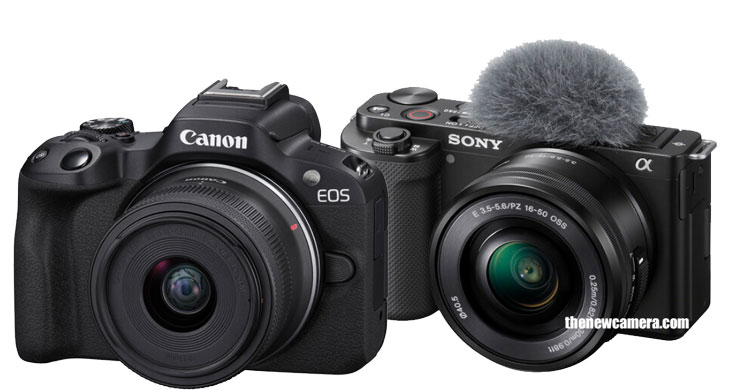
Let’s talk about the body design of both the camera the Canon R50 camera is more photographer friendly with the EVF and the deep hand grip that is missing in the Sony ZV-E10 camera
As you can clearly see Canon R50 and Sony ZV-E10 have different design approaches, Canon R50 has a more traditional, like a DSLR camera with a deep handgrip and also EVF for daylight shooting, while the Sony ZV-E10 may have a more modern, bit more compactish design that looks more vlogger friendly. Ultimately, the best camera for you will depend on your specific needs, shooting style, and set of available lenses (Open lens mount or close etc )
If you are a photographer and looking for a camera that has a more photographer-friendly design, it’s better to look up the Nikon z50 or maybe the Sony A6400.
But we have to also remember that the Canon RF mount supports a limited amount of lenses since it’s a closed mount and in Sony, we have an amazing range of lenses starting from the affordable to the g master series and the Sony lens amount of Sony is open from 2011. so literally, you have to be very conscious before making your decision
Get Canon R50 From Amazon.com | B&H Store
Get Sony ZV-E10 Camera from Amazon.com | B&H Store
| Lens Mount |
Canon RF |
Sony E |
| Sensor Resolution |
Effective: 24.2 Megapixel |
Actual: 25 Megapixel
Effective: 24.2 Megapixel (6000 x 4000) |
| Sensor Type |
22.3 x 14.9 mm (APS-C) CMOS |
23.5 x 15.6 mm (APS-C) CMOS |
| Crop Factor |
1.6x |
1.5x |
| Image Stabilization |
None (Video)
|
Digital (Gyro Based) |
| Built-In ND Filter |
None |
None |
| Capture Type |
Stills & Video |
Stills & Video |
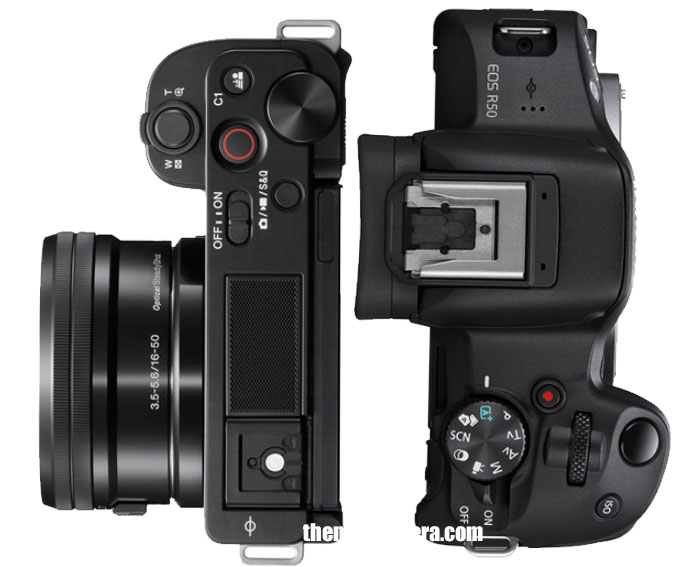
After the body design let’s compare the internal core specification of both cameras.
The Canon R50 camera features the same 24-megapixel sensor that we have seen in the Canon R10 camera, and also here the Sony ZV-E10 camera uses 24MP sensor, which we have seen in the Sony 6400 camera or A6600 camera.
| Shutter Type |
Electronic Shutter |
Electronic Shutter, Mechanical Focal Plane Shutter |
| Shutter Speed |
Electronic Shutter
1/8000 Up to 30 Seconds
Electronic Front Curtain Shutter
1/4000 Up to 30 Seconds |
Mechanical Shutter
1/4000 to 30 Seconds
1/4000 to 1/4 Second in Movie Mode |
| Bulb/Time Mode |
Bulb Mode, Time Mode |
Bulb Mode |
| ISO Sensitivity |
Photo/Video
100 to 32,000 (Extended: 51,200) |
Photo
100 to 32,000 in Auto Mode (Extended: 50 to 51,200)
Video
100 to 3200 |
| Metering Method |
Center-Weighted Average, Evaluative, Partial, Spot |
Center-Weighted Average, Multi-Zone, Spot |
| Exposure Modes |
Aperture Priority, Manual, Program, Shutter Priority |
Aperture Priority, Auto, Manual, Program, Shutter Priority |
| Exposure Compensation |
-3 to +3 EV (1/3 EV Steps) |
-5 to +5 EV (1/3, 1/2 EV Steps) |
| Metering Range |
-2 to 20 EV |
-2 to 20 EV |
| White Balance |
Presets: Auto, Cloudy, Color Temperature, Custom, Daylight, Flash, Fluorescent (White), Shade, Tungsten |
Presets: Auto, Cloudy, Color Temperature Filter, Custom, Daylight, Flash, Fluorescent (Cool White), Fluorescent (Day White), Fluorescent (Daylight), Fluorescent (Warm White), Incandescent, Shade, Underwater |
| Continuous Shooting |
Electronic Shutter
Up to 15 fps for up to 28 Frames (JPEG) / 7 Frames (Raw)
Electronic Shutter
Up to 12 fps for up to 42 Frames (JPEG) / 7 Frames (Raw) |
Up to 11 fps at 24.2 MP for up to 116 Frames (JPEG) / 46 Frames (Raw) |
| Interval Recording |
Yes |
Yes |
| Self-Timer |
2/10-Second Delay |
2/5/10-Second Delay |
AutoFocus Performancee
As you can see the number of AF points in Canon R50 is 4503 DPAF points for stills and 3713 DPAF points for Video. And when we compare it with the Sony’s ZV-E10 425 Hybrid AF points the comparison look meaningful less for a moment, but its not about how many numbers of AF points a camera has or fabricated inside it, the key factor of todays Mirrorless AF system in the Artificial Intelligent Algorithms inside the camera, and that’s the biggest reason why despite of having less number of AF points the AF performance of The Sony ZV-E10 is flawless.
| Focus Type |
Auto and Manual Focus |
Auto and Manual Focus |
| Focus Mode |
Continuous-Servo AF, Manual Focus, Single-Servo AF |
Automatic, Continuous-Servo AF, Direct Manual Focus, Manual Focus, Single-Servo AF |
| Autofocus Points |
Photo
Phase Detection: 4503
Video
Phase Detection: 3713 |
Phase Detection: 425
Contrast Detection: 425 |
|
|
-3 to +20 EV |
Canon R10 – Fastest Shooting Entry-level camera
For the first time Canon has introduced an electronic shutter inside an Entry level body, now with the help of an electronic setter we are able Burst upto 15FPSbut, but sadly the buffer is limited to 30 Frames of JPEG, so you can hardly have two second buffer slot with the Canon R50 Camera.
Sony ZV-E10 camera has a limited Brust speed of 11 frames per second, but at the same time the buffer memory of Sony’s ZV-E10 camera is much more than that of the Canon R50, with the ZV-E10 camera you are able to record 116 frames of JPEG in a single Brust and 46 frames of RAW0
Since Canon R50 camera uses a Canon R10 camera sensor and the samples of Canon R5 isn’t available right now, that’s why we are keeping the R10 image samples in our comparison list, so you can have an idea how will R50 will perform against the Sony ZV-E10
BASE ISO TEST

In the base are you so test you can clearly see both cameras are performing equally well, the detail capturing ability of both the camera is good at the base ISO range.
HIGH ISO TEST

Now let’s talk about the HIGH ISO TEST of both the camera, As now you can see the Sony ZV-E10 camera is able to preserve slightly more details in some specific situations compared to the Canon R50 Mirrorless camera, so for low light purposes of course Nikon ZV-E10 is bit more helpful.
Video Specs
| Internal Recording Modes |
H.264/H.265/MPEG-4
UHD 4K (3840 x 2160) at 23.98/25/29.97 fps
1920 x 1080 at 23.98/25/29.97/50/59.94/100/120 fps |
H.264/H.265/MPEG-4
UHD 4K (3840 x 2160) at 23.98/25/29.97 fps
1920 x 1080 at 23.98/25/29.97/50/59.94/100/120 fps |
| Broadcast Output |
NTSC/PAL |
NTSC/PAL |
| Built-In Microphone Type |
Stereo |
Stereo |

Best Entry-Level Camera to Record Videos?
Both cameras share exactly the same video Resolution and frame rates, Canon R50 camera as well as the Sony’s ZV-E10 camera records 4K videos up to 30 FPS and full HD videos up to 120 per second. So, for the first time, we have a Canon entry-level model that doesn’t crop in 4K. Undoubtedly it will bring smiles in face of Canon users, those who are waiting to upgrade their cameras from Canon M50 Mark ii or Canon 200D Mark II / SL3 . But, at the same time in 3rd generation of making APS-C Mirrorless cameras, the ZV-E10 is more video oriented and focuses on content creator requirements.
None of the cameras have any time recording limit in 4K 24 and 30 FPS recording video, but yes you have to carry extra battery packs says the batteries dry out quickly with these entry-level cameras when you are recording 4K.
Canon features DIGITAL Image stabilization mode in VIDEO, which we see generally in entry-level cameras, the mode works but with a cost of crop and it becomes unbearable and painful to your hands when you try to vlog with the Canon 18-45 kit lens, the 18mm wide generates a 24mm equivalent focal length of a full-frame camera and after that, once you apply Digital IS Mode, you hardly adjust yourself in the frame. So, if you want to vlog with an R50 camera, better to buy the Canon’s 15-30mm Lens OR at least an RF 16mm F2.8 Lens. But, unfortunately, the RF 16mm lens doesn’t have OIS Support. To better get the 15-30mm lens for vlogging if possible. As you know, we don’t have many options with Canon since the lens mount is locked and we have to select from a limited range of lenses.
Best lenses for Sony ZV-E10
But, the biggest surprise is we have a gyro image stabilization system inside the Sony ZV-E10 which works very effectively when you are shooting videos with the camera. Although using Gyro-based data is not that easy, either you have to use the catalyst browse software to stabilize your footage prior to editing, or Sony now also offers Catalyst plugin for premier pro software.
The range of available lenses is much more than you would expect, The Best Sony ZV-E10 Lens for Vlogging in 2023 is Sony 11mm F1.8 Lens, The lens captures a super wide 16mm full-frame equivalent look and a BRIGHT F1.8 aperture perfect for vlogging.
The Sony ZV-E10 also features a 3-capsule-based enhanced internal microphone design that captures audio much better than you would expect from a regular entry-level camera, as well as to monitor that audio you also get an extra 3.5mm headphone port. Which is not available with the Canon R50.
Of course, a Range of dedicated modes is also there which includes face exposure priority, product showcase, and skin softening mode for vloggers.
Interface
| Media/Memory Card Slot |
Single Slot: SD/SDHC/SDXC |
Single Slot: SD/SDHC/SDXC/Memory Stick Duo Hybrid (UHS-I) |
| Video I/O |
1 x Micro-HDMI Output |
1 x Micro-HDMI Output |
| Audio I/O |
1 x 1/8″ / 3.5 mm TRS Stereo Microphone Input on Camera Body |
1 x 1/8″ / 3.5 mm TRS Stereo Headphone Output
1 x 1/8″ / 3.5 mm TRS Stereo Microphone Input |
| Other I/O |
1 x USB-C Input/Output |
1 x USB-C Input/Output |
| Wireless |
2.4 / 5 GHz Bluetooth 4.2 Control |
1 x USB-C (USB 3.2 / 3.1 Gen 1) Input/Output (Shared with Power Input) |
| Mobile App Compatible |
Yes
*As of February, 2023: Check with manufacturer for the most up-to-date compatibility |
Wi-Fi, Bluetooth |
| Global Positioning (GPS, GLONASS, etc.) |
None |
None |
Best Camera for shooting Still Images and video?
Canon R50 overall design is more appealing to photographers since the camera also features EVF and a better handgrip, we also have an advanced AF system with AI AF object tracking mode and faster burst speed it looks ver impressive. But, at the same time you can see from the results of the High ISO Test, the Sony ZV-E10 sensor is preserving more details, if u want a more video-oriented camera with features like an advance microphone, dual 3.5mm jack, gyro-based IS, and product showcase mode, ZV-E10 best for you.
The Next BIG thing is Canon’s Locked lens mount. So, the range of lenses for an entry-level shooter is less (if you have a limited-budget lens ).
So, overall it depends upon who is buying the camera if he/she is a casual shooter. Not interested in having extra lenses and love the R50 design, then yes for you guys the R50 is best. But for those who are more serious with photography or video at the same time they have a limited budget, better to buy a Sony ZV-E10 camera (or A6400 is you are a photographer).
Get Canon R50 From Amazon.com | B&H Store
Get Sony ZV-E10 Camera from Amazon.com | B&H Store
By admin, on February 8th, 2023
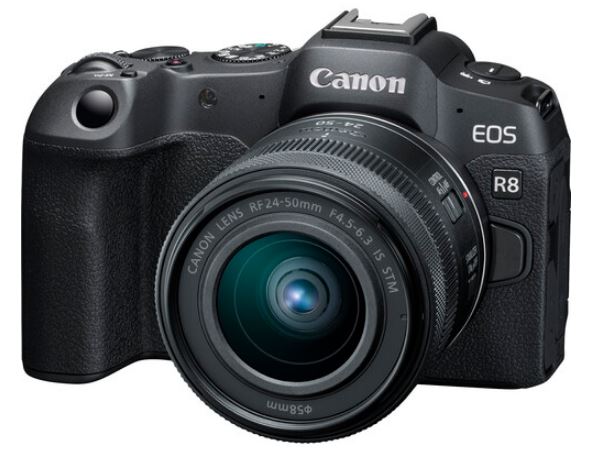
Canon R8 camera announced the camera features a 24MP full frame DPAF sensor, the same sensor we have seen in the Canon R6 Mark II camera. The Image processor is also the same, but the only thing that isn’t the same is the absence of IBIS. The Canon R8 features 4897 AF Points and 1053 AF Zones in the sensor. So, you get approx 100% coverage from your camera. According to Canon, the Canon R8 camera is loaded with more machine learning in its AF algorithms and inherits some of the technology from its flagship EOS R3 (but not the R3’s eye-controlled AF system). This should result in in super fast Autofocus Tracking performance.
Same as of the Canon R6 II, the Canon R8 also features enhanced tracking modes that are not only limited to ‘people’ and ‘animals, now you can also track a vehicle, cars, motorcycles, aircraft (including helicopters), and trains. Animal tracking also supports horses and zebras. So, the AF system of the camera is the best in its class. It’s capable of burst rates up to 40fps with the electronic shutter, though the camera drops to 12-bit readout to achieve this. Now, let’s have a look at the video core specification
The Canon R8 camera is capable to record UHD 4K/60p video via full sensor readout– no crop. It’s also possible to capture 4K/60p from an APS-C crop of the sensor. According to Canon, the Canon R8 uses almost the same heat sink mechanism as the Canon R6 mark II camera, you can record 4k 60fps videos up to 40 minutes without any issue. There are no time restrictions when shooting at slower frame rates like 4K/30p or 4K/24p. At Full HD video mode you can shoot up to 180 FPS.
Canon R8 Major Specification
-Effective 24.2-megapixel Fullframe CMOS sensor (with low-pass filter)-No
sensor self-cleaning function-
DIGIC X
-EVF 0.39 inches, 2.36 million dots organic EL, 100% field of view, magnification 0.96 Double, eye point 22mm
– AF is dual pixel CMOS AF, still supports EV -4.0 to 20
– 651 AF points (auto) for still, 57 points for video
– Still AF points (manual) is 4503 points, movie is 3713 points
– AF supports EV – 4.0 to 20 for stills, EV – 3.5 to 20 for movies
– 384-segment metering, metering range from EV -2 to 20 for stills, EV 0 for movies From 20
– Subject recognition, people, animals (dogs, cats, birds), vehicles (motor sports cars, motorcycles), eye recognition
– ISO range 100-32000 (ISO 51200 with extension)
– Electronic front curtain and electronic shutter
– Electronic front curtain shutter speed 1/4000-30 seconds, electronic 1/8000-30 seconds
Synchronization electronic front curtain 1/250 seconds
No in-body image stabilization
3 inch monitor, 1.62 million Dot, touch panel
– Wi-Fi, Bluetooth
– USB Type-C terminal (USB2.0), HDMI Type D terminal Clean output compatible
– 3.5mm microphone terminal, 3.5mm headphone terminal
– Battery is LP-E17
– Optional battery grip is not available
– Startup time is 0.4 seconds
– Dimensions are 116.3mm x 85.5mm x 68.8mm
– Body only weighs 328g (375g with accessories)
Get Canon R8 Camera from Amazon and B&H Store
Canon R8 Press Release
Canon Unveils the Revolutionary R8 Camera: A New Era in Photography
MELVILLE, NY, February 7, 2023 – Canon U.S.A., Inc., a leader in digital imaging solutions, announced today the launch of the new EOS R50 camera body, ideal for entry level users, and the EOS R8, an extremely compact, full-frame camera aimed at advanced amateur photo and video enthusiasts looking for budget-friendly options that don’t sacrifice performance. Additionally, two new RF-Mount lenses are being introduced to the ever-growing R-mount lens lineup.
EOS R50
Compact, lightweight and ideal for those looking to step up their video quality, the EOS R50 provides an impressive movie-shooting experience thanks to the APS-C sensor, with 4K video, uncropped 4K capture (at all frame rates), and outstanding Dual Pixel CMOS AF technology. With the addition of whole area tracking, subject detection, and movie-prerecording, difficult photo and movie opportunities can be easier to capture with a 24.2-million-pixel, APS-C sized image sensor. In addition, the EOS R50 is equipped with an eye-level electronic viewfinder to help achieve shot steadiness and ease viewing in bright sunlight conditions. A great camera for those who are looking to lean into interchangeable lenses, the EOS R50 camera can capture travel adventures, family portraits, sports, wildlife and even help a small business with marketing imagery. For those who are budding content creators, the EOS R50 will be available later in 2023 as part of a Content Creator Kit – packaged with a microphone, lens and grip. Overall, the EOS R50 is truly a jack of all content creation trades.
“The first time I picked up the EOS R50, I noticed how light it was. When I saw the footage, I wondered how the quality can be so good when it’s this lightweight in my hand. My mind was blown!” Bianca Matisse Taylor – Content creator and blogger
EOS R8
The EOS R8 — affordable and functional — is a full-frame mirrorless camera aimed at the up-and-coming video or photo enthusiast. This camera comes with class-leading autofocus while still extremely capable for everyday and general photography use. Equipped with a 24.2-megapixel CMOS image sensor and DIGIC X image processor, the EOS R8 is optimal for full-frame RF lenses — allowing enhanced wide-angle field of views when compared to APS-C sensor cameras. Extremely lightweight and compact, the EOS R8 shoots up to 6-fps with 1st-curtain Electronic shutter, and up to 40-fps with full electronic. For users who’ve already explored interchangeable lens cameras but haven’t yet broken into mirrorless, the EOS R8 should be the camera that takes them over the threshold to capture events, weddings, still life, travel and pets.
“My work is a lot about movement and not missing a beat with the fast shutter on the EOS R8 is so important to me as an artist.” Jasper Soloff – Photographer and Director
Additional product specs include:
Video performance
- Uncropped 4K video to 59.94p (29.97p with EOS R50) (with 6k oversampling)
- Full-HD to 59.94 fps, and High Frame Rate to 119.8 fps (Full HD 180p EOS R8)
- Dual Pixel CMOS AF, with subject detection for people, animals and vehicles
- Up to 2 hours of continuous recording (one hour with EOS R50); no 30 min limit
- Focus breathing correction
Enhanced usability for video correction
- Vertical Video Metadata
- Movie Self Timer
- Audio Noise Reduction (only in EOS R8)
- UVC/UAC Support, for USB livestreaming
- Recording Emphasis
- Aspect Markers
Connectivity
- Easy wireless connection from camera to compatible smartphone
- Camera Connect with USB connection to compatible smartphone
- USB streaming direct to computer via Zoom™, Teams™, or Skype™
- MFI Certified (Apple); WPA3-Personal protected access
- Convenient firmware updates via compatible smartphone
- Cloud RAW processing
Alongside the camera bodies, Canon will release two new lenses. The RF-S lens line, optimized for the smaller APS-C sensor size, expands with the Canon RF-S55-210mm F5-7.1 IS STM lens. This is a telephoto zoom, giving coverage equivalent to an 88–336mm lens on a full-frame camera. The lens opens the door to telephoto photography and videography, with 4.5 stops optical image stabilization, and close-focusing that can fill the frame with a subject roughly 2×3 inches in size (at its 210mm zoom setting, and minimum focus distance). And it does all this in an incredibly lightweight and compact package.
The Canon RF24-50mm F4.5-6.3 IS STM is a new, compact standard zoom lens for full-frame EOS R-series cameras. Ranging from true wide-angle to traditional “standard lens” coverage at 50mm, the lens is a travel friendly design with an extremely compact exterior. The RF24-50mm F4.5-6.3 IS STM lens is just over 2 inches long when fully retracted, and under 3.5 inches when extended — weighing less than half a pound. Optical Image Stabilization, with 4.5 stops of shake-correction, further enhances its appeal for video and still-image shooting. It’s also useable on an APS-C sensor Canon camera, where the lens’ effective coverage is equivalent to what a 38–80mm would deliver on a full-frame camera.
Price & Availability
The Canon EOS R8 camera body will be available for an estimated retail price of $1,499.00*. The Canon RF24-50mm F4.5-6.3 IS STM lens with the EOS R8 will have an estimated retail price of $1,699.00*. The Canon EOS R50 camera body will be available for an estimated retail price $679.99*. The EOS R50 with the RF-S18-45mm 4.5-6.3 IS STM lens will be available for an estimated retail price of $799.99.* The EOS R50 with the RF-S18-45mm 4.5-6.3 IS STM and RF-S55-210mm F5-7.1 IS STM lenses will be available for an estimated retail price of $1,029.00* The RF24-50mm F4.5-6.3 IS STM lens will be available for an estimated retail price $299.99* while the RF-S55-210mm F5-7.1 IS STM lens will have an estimated retail price of $349.99*. All products are currently scheduled to be available in Spring 2023.
By admin, on February 2nd, 2023
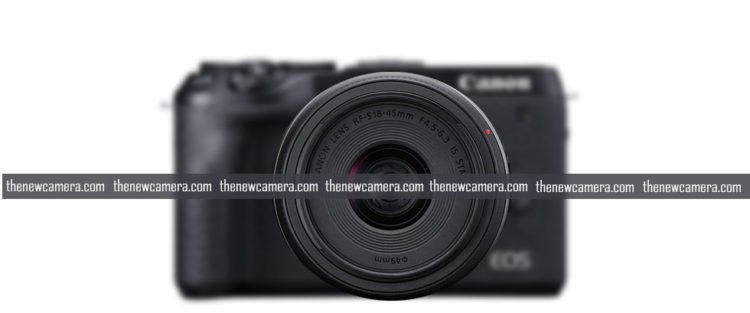
We have already published details about Canon’s upcoming announcement in our previous post here. Canon is about to announce Canon R8 and Canon R50, but at the time when we published that post, we didn’t know about the announcement date.
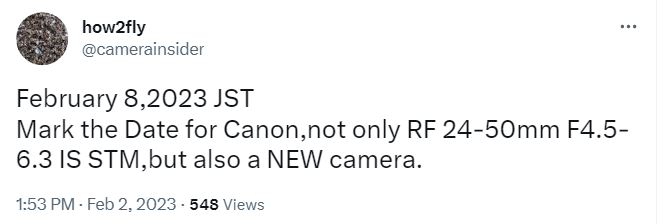
But, how to fly Twitter handle revealed that Canon is about to announce a new Camera and lens (24-50 F4.5 – 6.3) on Feb 8 2023. Although no further information was provided by the tipster.
We, do hope and expect Canon R8 and Canon R50 will arrive on the same day, now we are waiting for specifications and images of the upcoming Canon cameras and lenses. Stay tuned, we will be posting that soon.
Get LIVE RUMORS –> FACEBOOK | TWITTER | INSTAGRAM to get live news + Canon rumors 24X7
source howtofly
By admin, on January 31st, 2023
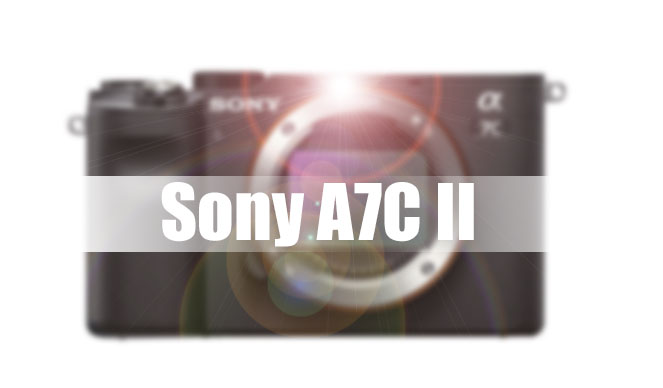
According to the latest rumors, The Sony A7C Mark II camera is coming with the same 33MP full-frame Exmor R CMOS BSI sensor and the same IBIS unit, that we have seen in the Sony A74 camera. But, the EVF is expected to remain the same as the Sony A7C Camera.
Take a look at what the source said to the rumor mill
We can expect A7C II next year. Sony already reserved some components from A7IV for “another camera” including for example sensor and IBIS. Also they scheduled increased production ONLY for EVF from A7C mk1 for this year. So we are expecting A7C II same specs as A7IV, redesigned shell but same EVF like mk1.
On Nov 26th, 2022 in one of our articles published [Sony upcoming cameras of 2023] we told back then the Sony A7C Mark II camera will arrive in Q3 / Q4 of 2023 with the same sensor that we have seen in Sony A74. Now, we are getting the same confirmation from other rumor mills too.
Latest Sony A7C Mark II – Rumor Analysis
Is the rumored information correct or not? Yes, we do know based on the scheduled announcement patterns of these Mirrorless makers, there is a high probability that we will see the Sony A7C Mark II camera in the year 2023 and we have said the same in our previous post too.
But the big question is, as the source said the Sony A7C Mark II will use the same sensor and IBIS unit as the Sony A7 IV camera,
1. Sony 33MP Full-Frame Exmor R CMOS BSI Sensor in A7C Mark II
Let’s talk about 33MP Sensor only – The source speculates that the A7C Mark II will feature the same sensor as the A7 IV, which is a strong possibility given that it’s already been 10+ months since the A7 IV was released, and as the market competition is begin raised up and competitors like Panasonic S5 Mark II | S5X arrived, they have no other option then to make an affordable Sony A74 mark IV curry for Cinematographers and content creators if they want to survive in $2000 body price range of cameras (against Pannsonic S5 II), As you know the Sony A7 C Mark I look drastically weak in front of S5 Mark II and yes, the Sony FX30 is a good option for beginner cinematographers but it features an APS-C CMOS sensor, the A7C Mark II will be a perfect competitor of Panasonic S5 Mark II if they upscale the video core specs (Like 4k 60p uncropped) and remove the overheating issue from the camera.
Not only that, the A7C Mark II is expected to have a more content creators-friendly body design, to make it more user-friendly undoubtedly we will see some sacrifice in the controls or EVF part compared to the A74. So, the Sony A7 IV camera will remain safe in its place if someone wants a super perfect Hybrid Camera more for photography and a bit less for dedicated video work A7 IV is still the perfect option for them, but at the same time the Sony A7C Mark II will not only attract a new consumer base, but it will also stop the migration of Sony users to a different brand like Panasonic or Canon.
2. Same or Redesigned Sony A7 IV IBIS Unit inside A7C Mark II Body?
Ok, the sensor part is perfect, but how is it possible, the upcoming Sony A7C Mark II will use the same IBIS unit as the Sony A7 IV camera ?.take a look at what dpreview said about the Sony A7C camera
Sony has redesigned its in-body stabilization system to fit into a much smaller body than before
Is the rumor mill source really correct with the set of information he shared with us? Since, if Sony uses the same IBIS Sensor mechanism of the Sony A74 IV camera in Sony A7C Mark II Body, the camera will lose its Truly compact form factor, will Sony camera division marketing team allow this to happen?. Yes, they can use a Redesigned version of the Sony A7 Mark IV IBIS unit to easily fit inside the Sony A7C Mark II body and the camera retains its compact form factor.
And yes, finally the EVF, the camera is made for cinematographers, content creators, and videographers so having a high-quality EVF isn’t that important in the upcoming Sony A7C Mark II camera. So, yes the Sony A7C Mark II may arrive with the same 2.36m-Dot OLED Electronic Viewfinder.
Updated Rumored Cores specification of Sony A7C Mark II based on latest rumors
Sony A7C Mark II Rumored Specification
- 33MP Full-Frame Exmor R CMOS Sensor
- BIONZ XR & AI Processing Unit
- Up to 10 fps Shooting, ISO 100-51200
- 4K 60p Video in 10-Bit, S-Cinetone
- 2.36m-Dot EVF
- 3″ 1.03m-Dot Vari-Angle Touchscreen LCD
- 759-Pt. Fast Hybrid AF, Real-time Eye AF
- Focus Breathing Compensation
- 5-Axis SteadyShot Image Stabilization
- Creative Looks and Soft Skin Effect
- 4K 15p UVC/UAC Streaming via USB Type-C
Follow us on our social pages FACEBOOK | TWITTER | INSTAGRAM, If you have time –>see more Sony Alpha Rumor
source – Sonyalpharumor website
By admin, on January 30th, 2023
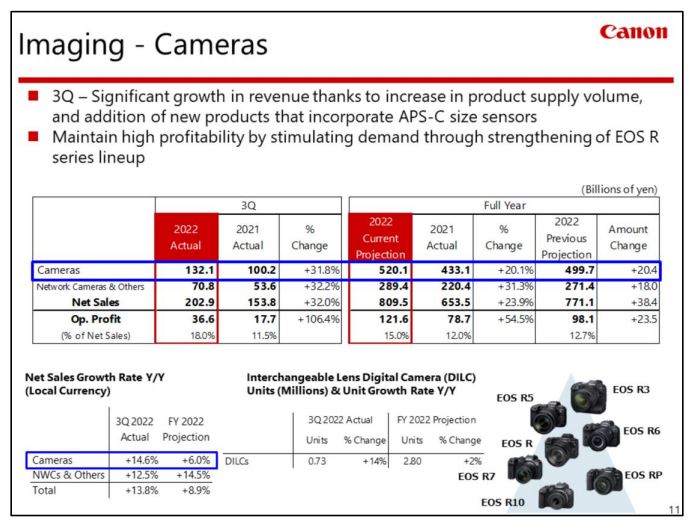
So, we have now the Canon financial results for Q4 2022. According to the report by Canon, the imagine (camera) division of CanonIn Q3, enjoying double-digit growth in unit sales, driven by higher product supply and new models, and the recently announced EOS R7 and R10, leading to significant revenue increase with lens sales.
More Details coming out from Canon Sales Report pdf
- Demand for cameras remains solid, even amid economic slowdown, thanks to the launch of new mirrorless models and interchangeable lenses by each company. As a result, we expect the market in 2022 to be 5.45 million units, a slight increase compared to last year.
- In the third quarter, thanks to the higher volume of product supply and the addition of new models, namely the EOS R7 and EOS R10, mirrorless cameras that incorporate APS-C size sensors, we posted double-digit growth in unit sales, and coupled with an increase in lens sales, a significant increase in overall revenue.
- Regarding our unit sales projection for the full year, we maintained our previous projection of 2.8 million units as we will not be able to supply enough products to meet demand. Going forward, we will continue to stimulate demand by steadily strengthening our lineup of EOS R series mirrorless cameras.
- Cameras that incorporate full-frame sensors, like the EOS R5 and EOS R6, continue to enjoy strong support from professionals and advanced amateurs. Additionally, the 2 new cameras that incorporate APS-C size sensors, with their light-weight and small form factor appeal, are encouraging users who want to enjoy serious photography to switch from SLR cameras or step up from entry models.
- We have also expanded our range of RF lenses to 32 models, providing users a variety of options.
- Going forward, we will continue efforts to expand our market share and maintain high profitability by building a more robust EOS R system lineup
Does the last line indicate Canon EOS R Mark II is Coming?
In the last line you can read, “expand our market share and maintain high profitability by building a more robust EOS R system lineup” the line suggests that Canon is planning to announce a new camera model or models that will attract and expand the user base of interchangeable lens cameras. This could mean that the new model may have features aka specifications that will appeal to a broader range of users, beyond just professionals and advanced amateurs. The goal may be to increase the popularity of interchangeable lens cameras and bring in new users who previously used other types of cameras or who have not used a camera before. So, it clearly indicates that Canon will refresh the entry-level EOS R Mirrorless line-up, so we can expect either the arrival of base models like Canon R50 / R100 as rumored earlier or EOS R Mark II / Canon R8 or maybe a mixed bag of announcements to appeal wide consumer base.
Also see Canon Upcoming Cameras 2023
Get LIVE RUMORS –> FACEBOOK | TWITTER | INSTAGRAM to get live news + Canon rumors 24X
source digicam-info | download the Canon sales report PDF
By admin, on January 29th, 2023
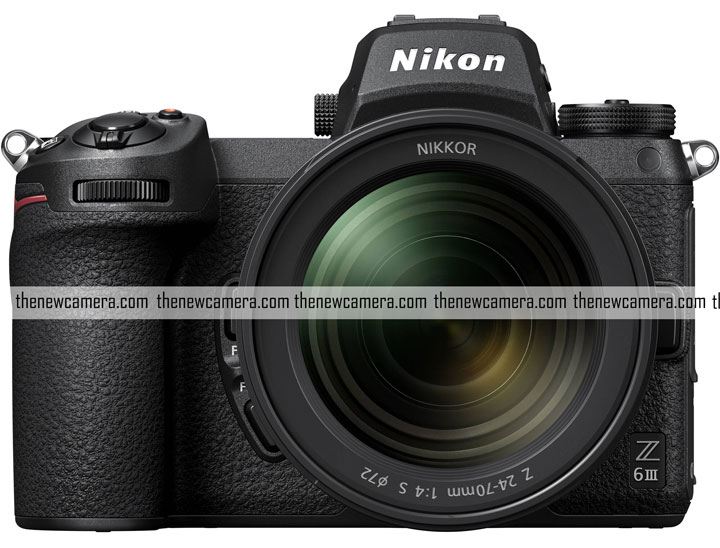
The Nikon Z6 Mark II camera is one of the most popular Nikon full-frame cameras of 2021 and 2022, I know a lot of my subscribers, those who are also into wedding photography and video purchased the same camera along with the 27-70mm F4 Lens and some were able to grab the 28-75mm F2.8 Lens. And guess what we have amazing viltrox lenses too for shooting portraits and candids at weddings. Kindly note that even if ur a fashion, travel, or landscape shooter the camera does have amazing features and extensive manual controls to get the best out of the camera.
If you going to talk about the price vs specification of this camera then it is one of the best cameras in its price range. The other two competitors we have in this price range are Sony A7C and Sony A73,
Should You buy Nikon Z6 mark II 2023?
If you can wait you should, we have already discussed about the arrival of the Nikon Z6 Mark III in one of our posts here. If Nikon goes according to its scheduled arrival time we will have Z6 III in the year 2023
Do you really want the camera on an urgent basis then, of course, you go with Nikon Z6 Mark II camera. Otherwise if ur easy with waiting time then you should wait for the better version. Since, as per rumors it’s coming this year.
Follow us on our social pages FACEBOOK | TWITTER | INSTAGRAM to get live news + Nikon Rumors 24X7
|
KEEP THIS BLOG ALIVE - Support New Camera Buy Canon Lenses, Buy Music CD or Digital Camera at amazon it helps this site, and you do not pay anything extra, it is just a way to help support this site.

|

















